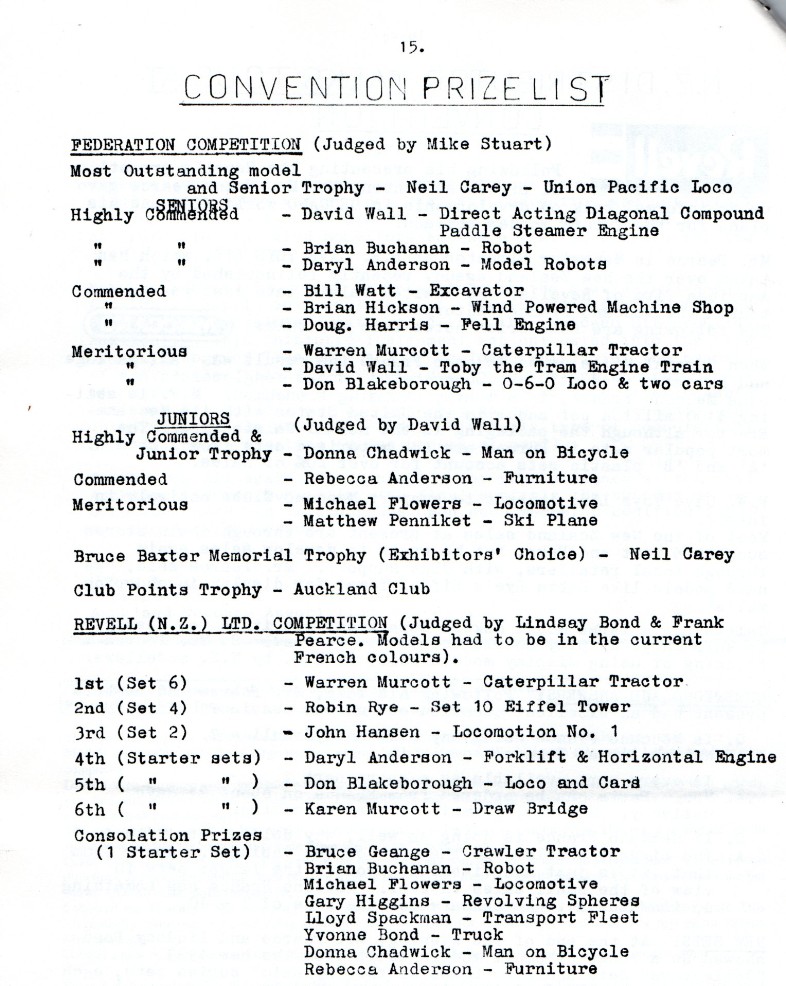NZFMM
Main menu:
- Home Page
- About NZFMM
- NZ Meccano Clubs
- NZFMM Magazine information
- Interactive Models
- April Antics 2010
- Te Papa Meccano Display 2010
- Te Papa Meccano Display 2012
- Historical NZFMM conventions
- 1993 Auckland Convention
- 1995 Christchurch Convention
- 1997 Feilding Convention
- 1999 Auckland Convention
- 2001 Wellington Convention
- 2003 Hawera Convention
- 2007 Wellington Convention
- 2009 Christchurch Convention
- 2011 MWT Palmerston North Convention
- 2013 Auckland Convention
- 2019 MWT Inglewood Convention
- 2021 Wellington Waikanae Convention
- 2023 Christchurch Tinwald Convention
- 2025 Whanganui Convention
- Articles
- Literature indexes
- Where to buy Meccano
- Links
1993 Auckland Convention
NZFMM 1993 Auckland Convention Introduction
The 1993 Bi-annual meeting of the New Zealand Federation of Meccano Modellers was held at Western Springs, Auckland. Below is a selection from the many fine models displayed at the convention. A list of the prizewinners is reproduced at the end.
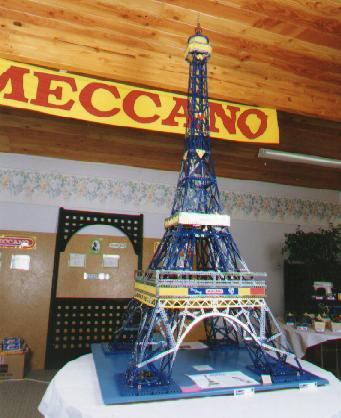
Eiffel Tower by Robin Rye
This magnificent model of the Eiffel Tower was built by Robin Rye of Taranaki. It is modelled in 1978 dark blue and yellow enamelled parts.
Robin built it from the set 10 model leaflet but added lots of extra bracing which has significantly improved the appearance of the model.
Locomotion No. 1 By John Hansen
Now preserved for posterity in the Darlington Railway Museum, Co. Durham, England, Locomotion No.1 was built by George Stephenson. It hauled the first-ever passenger train on its 'maiden' trip from Darlington to Stockton, a distance of 14 miles on Tuesday, September 27th, 1825.
This beautifully detailed model of John's is based on a plan published in the July 1978 Meccano Magazine.
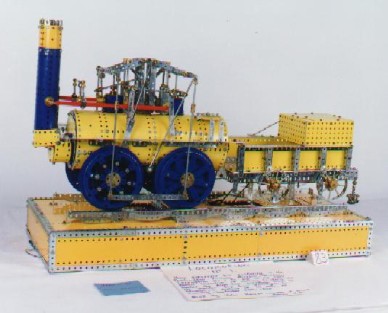
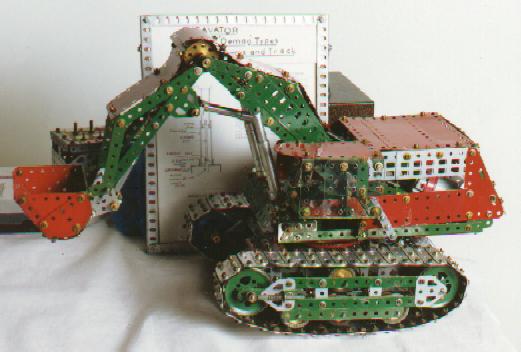
Demag Excavator by Bill Watt.
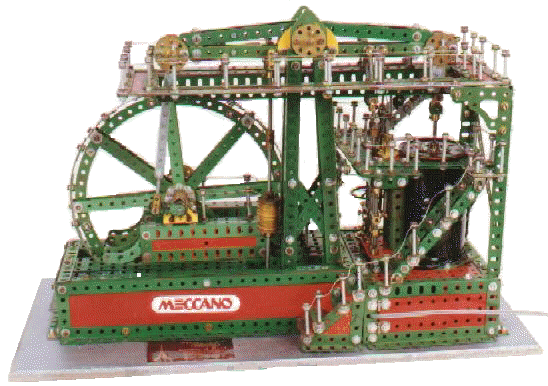
Beam Engine by Lindsay Bond
A freelance model of a Cornish "pumping" or beam engine by Lindsay Bond. The building that housed these engines formed the frame of the engine and supported the beam. The power stroke was not produced by the expansion of the steam, as in normal steam engines, but the condensation caused by spraying water into the cylinder full of steam. Thermodynamically therefore they were very inefficient and operated very slowly and with a characteristic hesitation before the condensation stroke - despite the flywheel it was noticeable.
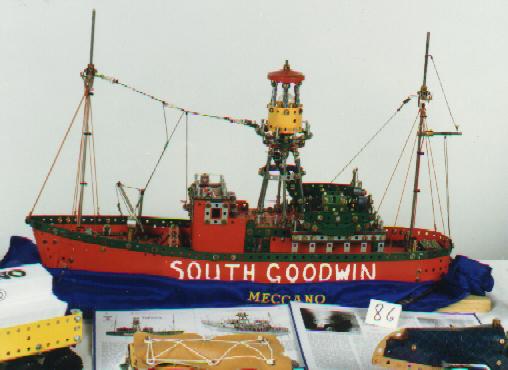
Lightboat by Lindsay Bond
A very popular display model distributed to Meccano Dealers in the mid-1950's. It was also the subject of the "Model of the Month" for the April 1957 Meccano Magazine. The boat was one of three guarding the South Goodwin sands, five miles off the Dover coast, almost on the threshold of the port of London. Ships, if they get stranded on the sand bars can be easily ripped apart by the tides. There is an excellent article on the subject on pages 520-521 of the November 1958 Meccano Magazine. All of these ships have now been replaced with automatic buoys.
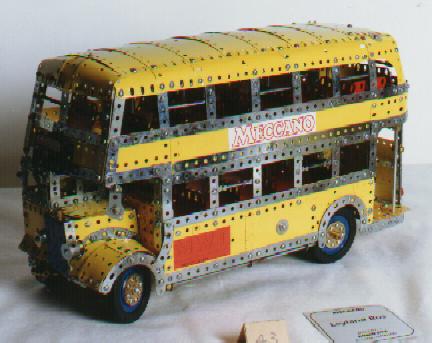
Leyland Bus by Robin Rye
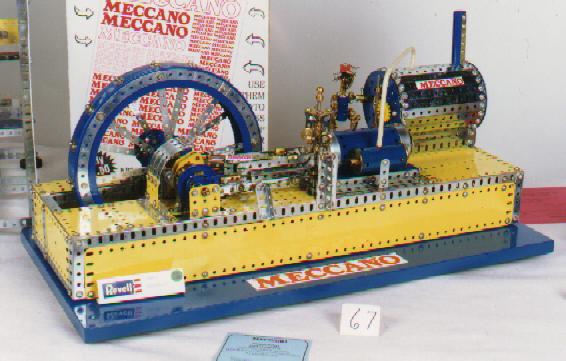
Steam Engine by Daryl Anderson
This steam engine is a totally free-lance model of Daryl's design. It is powered by a windscreen wiper motor.
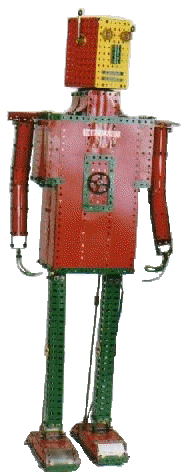
Walking Robot by Alistair Tong
This model is based on the Meccano Special Model Leaflet No. 27. Alistair however had to adapt the mechanism to make it work! The gear ratio needs to be increased.
As well as walking, the arms swing and the head revolves. Note the very long Achilles Tendon!
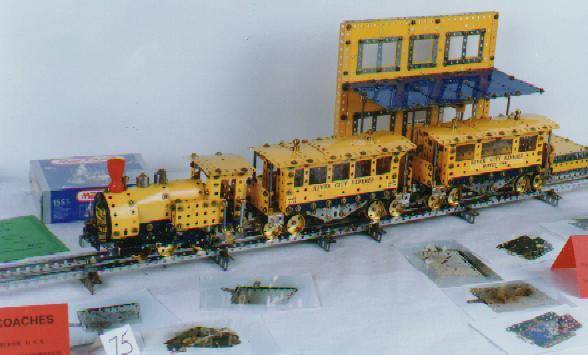
Railway Station & Stock by Don Blakeborough
Don built this model so the train would run out of the station for a short distance and stop. The train would stay stationary until the motor on the timer reversed the movement. This would set the engine going and the train would reverse back to the station. The third rail at each end, was electrically broken, to stop current to the engine.
The current was controlled by a timer and ran through relays which also electrically connected the break under the engine. Don had to experiment with the timing. If set too fast the train might not reach the station when suddenly the direction would be reversed. If set too slow the train would stop when it ran over the break, but would have to sit a long time before movement would begin again.
The sequence to control the direction of the engine is shown in the table below.
1 Out |
Power to centre section (+ to centre rail - to outer rails), + power to end section. Stop at end of run. |
2 Home |
Power to centre section (+ to centre rail - to outer rails), + power to end section. Stop at end of run. |
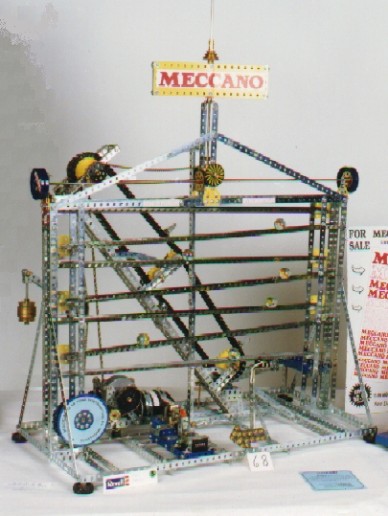
Marble Roller by Daryl Anderson
This marble monster was created by Daryl in 1990. He saw a wooden one where kids put the marbles in the top and watched them roll down. That was the inspiration. This model has a windscreen wiper motor which drives the mechanism that lifts the marbles to the top of the tracks.
At one stage Daryl had a counter from an old photocopier on it until it broke. When the counter was on, the count was 750 marbles per hour. Daryl has calculated it has moved well in excess of a million marbles since it was made. It recently went for 2 days at the Hawera A&P Show, and did not miss a beat. Kids spend hours watching the marbles!
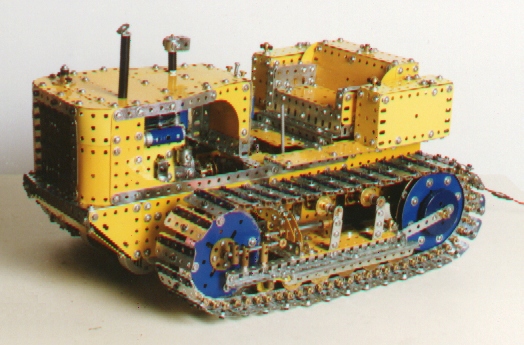
Crawler Tractor By Warren Murcott
Warren based this model on Eric Tylor's design that was first shown in the January 1977 Meccano Magazine. However he improved the gearbox and drive mechanism considerably.
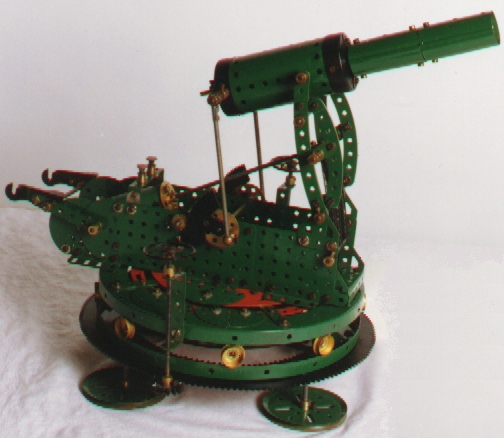
Disappearing Gun by Gary Higgins
This model is based on a disappearing gun. They were placed in fortifications guarding New Zealand's main ports in the last quarter of the nineteenth century. During the Crimean War there was a great fear that the Russians were going to sail down and attack New Zealand!

Union Pacific Railroad Locomotive & Tender by Neil Carey
Westfield locomotive engineer Neil Carey can't resist a challenge and that is exactly what he got when he built a Meccano model of 'Challenger' type 3985, the largest steam locomotive presently operating in the world. This model was just over 10 feet long and 56 kilograms!
The nine months of toil taken to construct the model earned Neil the Bruce Baxter Memorial Trophy for the most outstanding model at the exhibition.
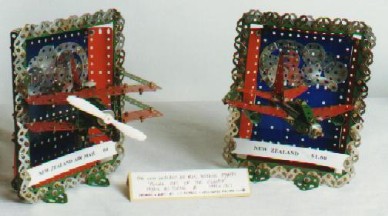
Two New Zealand Postage Stamps by Lou Nichols
"Flying Out Of The Clouds"
1920's Biplane & 1990's Jet
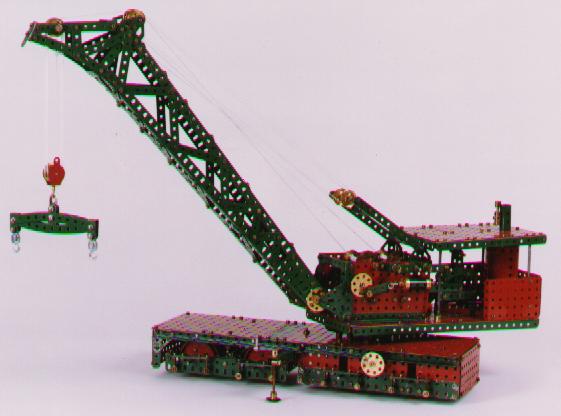
Railway Breakdown Crane by Doug Harris
This model is based on Super Model Number 30. The original weakly designed gearbox has been redesigned to provide hoisting, luffing, slewing and travelling outputs from a single input, all contained in a space of 4 by 4 by 7 holes. Each movement is braked by a worm gear. The travelling drive is automatically disengaged when the slew drive is engaged to avoid the tow locking up. Each output has forward, neutral and reverse positions, each retained by a spring loaded detent.
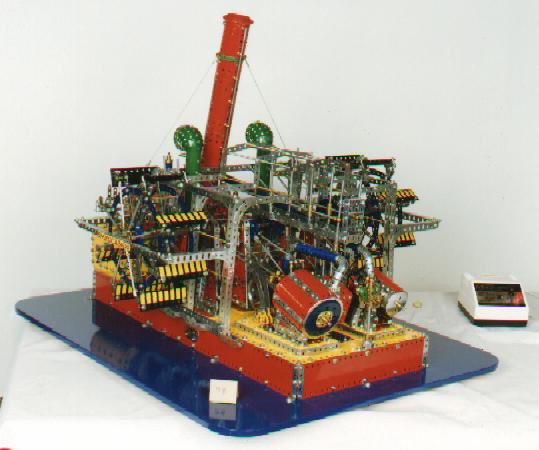
Paddle Steamer Engine with feathering blades by David Wall
Notes on the Model provided by David Wall
Marine Engine And Boiler Room
This type of engine and boiler arrangement was popular in the closing years of the 19th century to propel excursion vessels and tugs.
Engine
This is a direct acting diagonal compound type. Steam is admitted to the high pressure cylinder via a piston valve and to the low pressure cylinder via a slide valve. Both valves are activated by Stephenson's (reversing) valve gear. This type of engine normally ran at about 45 to 50 R.P.M. and was controlled by the engine stop valve to admit steam to the high pressure valve chest and a manually operated reversing gear to lift and lower the expansion links.
Boiler
The boiler is a single ended, three furnace, scotch type working at a pressure of 140 lbs/sq". Boiler fittings include a safety valve, inspection cover, main stop valve, whistle and auxiliary valve, two non return feed water valves, steam pressure gauge and valve, two water level gauges and scum and blow down valves.
Funnel
This is a natural draught outer cased type fitted with an uptake damper, whistle and waste steam pipes. It would be braced to the hull with four or more wire stays.
Paddles
These are fitted with feathering floats to reduce the impact and drag as the floats enter and leave the water.
Ancillary Equipment
The remaining engine/boiler room fittings include the surface condenser, air and circulating pumps, two Weir type feed water pumps, stoke hold ventilators, coal bunkers and an engine room telegraph repeater. Also fitted is the steam induction pipe leading from the boiler main stop valve to the engine stop valve and the education pipe leading from the low pressure valve chest to the condenser. Engine and boiler room access ways are also fitted. The engine and boiler room would have been illuminated by oil lamps.
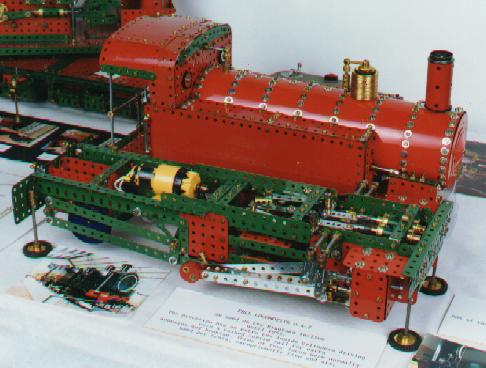
Fell Locomotive by Doug Harris
Fell-type Locomotive with fully working inside and outside valve gear and cylinders. It is a fascinating model to watch when it is running. A Fell railway once operated on the Rimutaka Hill between the Wairarapa and the Hutt Valley in New Zealand. The model is based on the first set of drawings of the proposed locomotive, and does not have the rear bunker, which makes it easier to view the fully detailed cab.
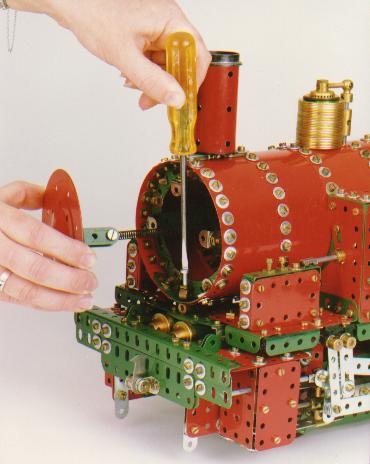
Left: Fell Locomotive detail showing how one bolt holds the body to the chassis.
The 'Fell' system uses a central rail between the running rails. Engines and other vehicles have rollers with vertical axes arranged in pairs so that they can grip the central rail - the gripping force is very large so that braking or tractive effort can be much larger than can be achieved through the running wheels. Locomotives use the gripping rollers for traction and braking - other vehicles for braking.
The last remaining engine from the Rimutaka line is preserved in a museum at Featherston. There is also an article about this railway on pages 476 to 478 of the September 1955 Meccano Magazine.
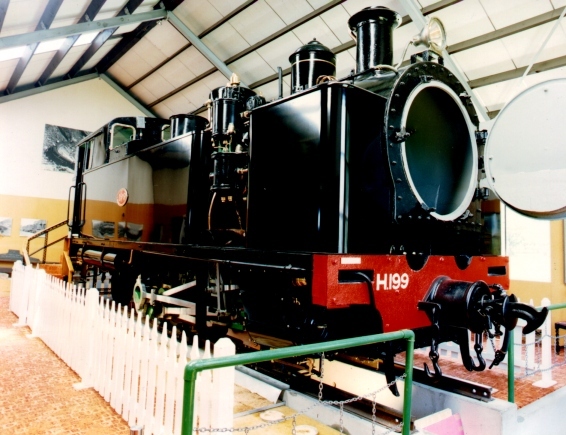
The last remaining Fell Locomotive preserved at Featherston, New Zealand.
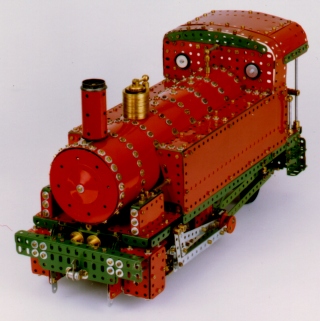
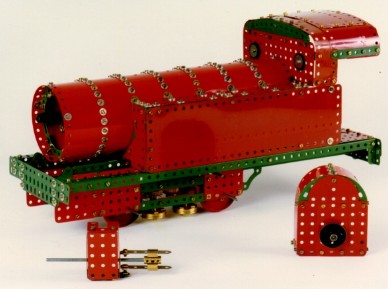
Meccano model of Fell Loco under construction, showing the horizontal driving wheels for gripping the raised centre rail.
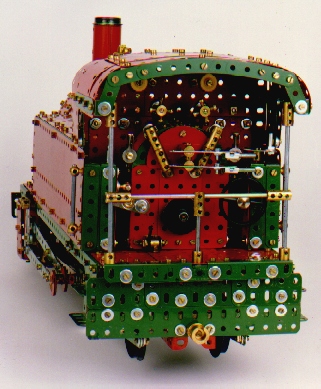
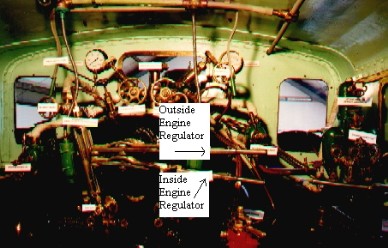
Cab interior of the Fell locomotive preserved at Featherstone in the Wairapara, New Zealand. Note the two throttle handles, centre, for the inside and outside cylinders. Doug has shown these details in his model.
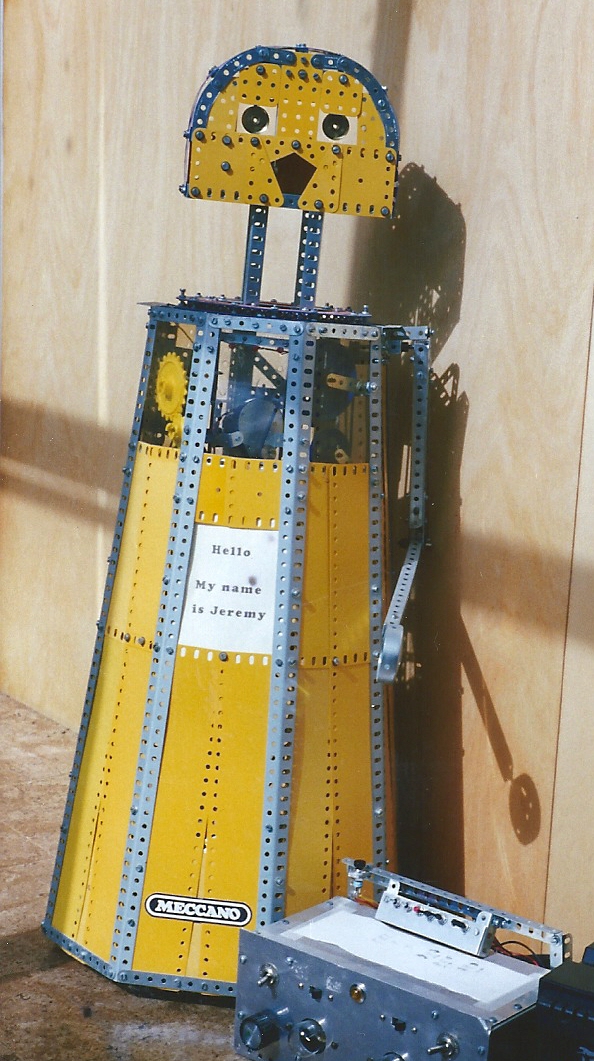
Jerry the Robot by Brian Buchanan
The covention prize list is reproduced below from the NZFMM magazine Vol 17 No. 2 , June 1993:
